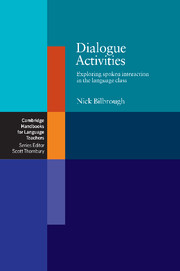Book contents
- Frontmatter
- Contents
- Thanks and acknowledgements
- Introduction
- 1 Understanding
- 2 Analysing
- 3 Reproducing and reconstructing
- 4 Memorising
- 5 Rehearsing and performing
- 6 Co-constructing
- 7 Creating and personalising
- 8 Communicating
- 9 Dialogue as learning
- Dialogue Bank A From the film Mulholland Drive
- Dialogue Bank B Authentic snippets
- Dialogue Bank C Snippets from fairy tales
- Dialogue Bank D Lame jokes
- Dialogue Bank E Situational dialogues
- Dialogue Bank F ‘Dating Agency’ from the comedy series Little Britain
- Further reading and resources
- Index
- Frontmatter
- Contents
- Thanks and acknowledgements
- Introduction
- 1 Understanding
- 2 Analysing
- 3 Reproducing and reconstructing
- 4 Memorising
- 5 Rehearsing and performing
- 6 Co-constructing
- 7 Creating and personalising
- 8 Communicating
- 9 Dialogue as learning
- Dialogue Bank A From the film Mulholland Drive
- Dialogue Bank B Authentic snippets
- Dialogue Bank C Snippets from fairy tales
- Dialogue Bank D Lame jokes
- Dialogue Bank E Situational dialogues
- Dialogue Bank F ‘Dating Agency’ from the comedy series Little Britain
- Further reading and resources
- Index
Summary
Hi. Welcome to this book. How are you doing? Do you want a cup of tea while you're reading?
This is rather an odd way to start a book, especially one which aims to look at the way in which dialogues can be used in language teaching and learning. Of course I cannot really offer you a cup of tea, and I can't even be sure that you drink tea! There may also be issues of register: I have adopted quite an informal style in what I have said to you, and I have no way of telling whether this is appropriate. On the other hand, there is a sense in which entering into dialogue with the people who are going to read this book is a good idea.
I'm assuming that, if you are reading this, then you are somehow involved in the teaching of languages. You are probably a busy teacher and are looking for some practical activities that you can do with your students. You may even be thinking about skipping this introduction and going straight to the sections with the activities. At the same time, you may be wondering about what exactly I mean by dialogue, and whether this book will offer you anything in the way of new ideas.
- Type
- Chapter
- Information
- Dialogue ActivitiesExploring Spoken Interaction in the Language Class, pp. 1 - 17Publisher: Cambridge University PressPrint publication year: 2007



